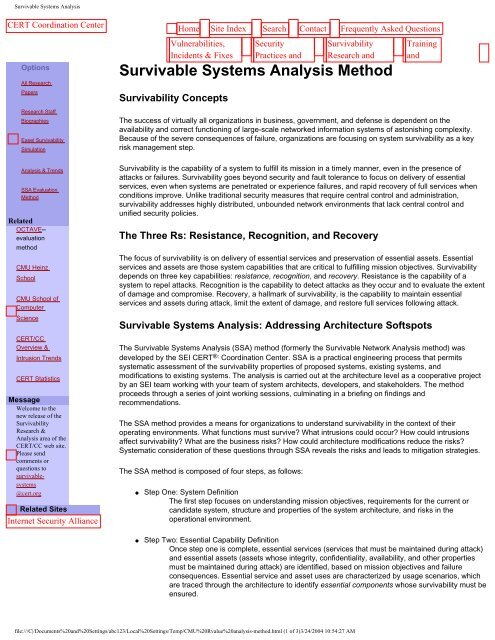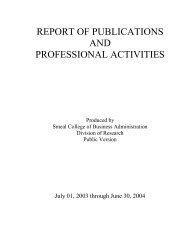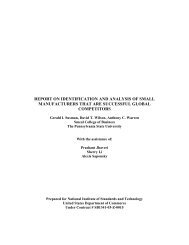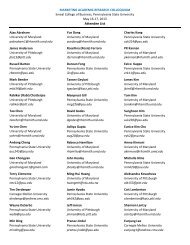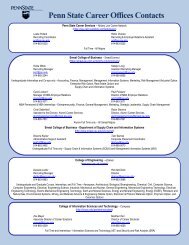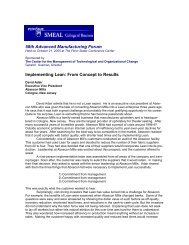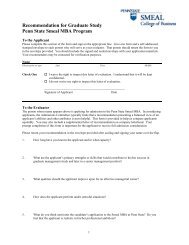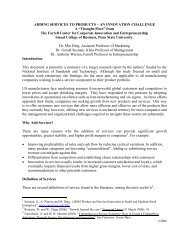Survivable Systems Analysis - Smeal College of Business
Survivable Systems Analysis - Smeal College of Business
Survivable Systems Analysis - Smeal College of Business
You also want an ePaper? Increase the reach of your titles
YUMPU automatically turns print PDFs into web optimized ePapers that Google loves.
<strong>Survivable</strong> <strong>Systems</strong> <strong>Analysis</strong><br />
CERT Coordination Center<br />
Options<br />
All Research<br />
Papers<br />
Research Staff<br />
Biographies<br />
Easel Survivability<br />
Simulation<br />
Home Site Index Search Contact Frequently Asked Questions<br />
Vulnerabilities,<br />
Incidents & Fixes<br />
Security<br />
Practices and<br />
Evaluations<br />
Survivability<br />
Research and<br />
<strong>Analysis</strong><br />
<strong>Survivable</strong> <strong>Systems</strong> <strong>Analysis</strong> Method<br />
Survivability Concepts<br />
Training<br />
and<br />
Education<br />
The success <strong>of</strong> virtually all organizations in business, government, and defense is dependent on the<br />
availability and correct functioning <strong>of</strong> large-scale networked information systems <strong>of</strong> astonishing complexity.<br />
Because <strong>of</strong> the severe consequences <strong>of</strong> failure, organizations are focusing on system survivability as a key<br />
risk management step.<br />
<strong>Analysis</strong> & Trends<br />
SSA Evaluation<br />
Method<br />
Related<br />
OCTAVE sm<br />
evaluation<br />
method<br />
CMU Heinz<br />
School<br />
CMU School <strong>of</strong><br />
Computer<br />
Science<br />
CERT/CC<br />
Overview &<br />
Intrusion Trends<br />
CERT Statistics<br />
Message<br />
Welcome to the<br />
new release <strong>of</strong> the<br />
Survivability<br />
Research &<br />
<strong>Analysis</strong> area <strong>of</strong> the<br />
CERT/CC web site.<br />
Please send<br />
comments or<br />
questions to<br />
survivablesystems<br />
@cert.org<br />
Related Sites<br />
Internet Security Alliance<br />
Survivability is the capability <strong>of</strong> a system to fulfill its mission in a timely manner, even in the presence <strong>of</strong><br />
attacks or failures. Survivability goes beyond security and fault tolerance to focus on delivery <strong>of</strong> essential<br />
services, even when systems are penetrated or experience failures, and rapid recovery <strong>of</strong> full services when<br />
conditions improve. Unlike traditional security measures that require central control and administration,<br />
survivability addresses highly distributed, unbounded network environments that lack central control and<br />
unified security policies.<br />
The Three Rs: Resistance, Recognition, and Recovery<br />
The focus <strong>of</strong> survivability is on delivery <strong>of</strong> essential services and preservation <strong>of</strong> essential assets. Essential<br />
services and assets are those system capabilities that are critical to fulfilling mission objectives. Survivability<br />
depends on three key capabilities: resistance, recognition, and recovery. Resistance is the capability <strong>of</strong> a<br />
system to repel attacks. Recognition is the capability to detect attacks as they occur and to evaluate the extent<br />
<strong>of</strong> damage and compromise. Recovery, a hallmark <strong>of</strong> survivability, is the capability to maintain essential<br />
services and assets during attack, limit the extent <strong>of</strong> damage, and restore full services following attack.<br />
<strong>Survivable</strong> <strong>Systems</strong> <strong>Analysis</strong>: Addressing Architecture S<strong>of</strong>tspots<br />
The <strong>Survivable</strong> <strong>Systems</strong> <strong>Analysis</strong> (SSA) method (formerly the <strong>Survivable</strong> Network <strong>Analysis</strong> method) was<br />
developed by the SEI CERT ®: Coordination Center. SSA is a practical engineering process that permits<br />
systematic assessment <strong>of</strong> the survivability properties <strong>of</strong> proposed systems, existing systems, and<br />
modifications to existing systems. The analysis is carried out at the architecture level as a cooperative project<br />
by an SEI team working with your team <strong>of</strong> system architects, developers, and stakeholders. The method<br />
proceeds through a series <strong>of</strong> joint working sessions, culminating in a briefing on findings and<br />
recommendations.<br />
The SSA method provides a means for organizations to understand survivability in the context <strong>of</strong> their<br />
operating environments. What functions must survive? What intrusions could occur? How could intrusions<br />
affect survivability? What are the business risks? How could architecture modifications reduce the risks?<br />
Systematic consideration <strong>of</strong> these questions through SSA reveals the risks and leads to mitigation strategies.<br />
The SSA method is composed <strong>of</strong> four steps, as follows:<br />
●<br />
Step One: System Definition<br />
The first step focuses on understanding mission objectives, requirements for the current or<br />
candidate system, structure and properties <strong>of</strong> the system architecture, and risks in the<br />
operational environment.<br />
●<br />
Step Two: Essential Capability Definition<br />
Once step one is complete, essential services (services that must be maintained during attack)<br />
and essential assets (assets whose integrity, confidentiality, availability, and other properties<br />
must be maintained during attack) are identified, based on mission objectives and failure<br />
consequences. Essential service and asset uses are characterized by usage scenarios, which<br />
are traced through the architecture to identify essential components whose survivability must be<br />
ensured.<br />
file:///C|/Documents%20and%20Settings/abc123/Local%20Settings/Temp/CMU%20Rvalue%20analysis-method.html (1 <strong>of</strong> 3)3/24/2004 10:54:27 AM
<strong>Survivable</strong> <strong>Systems</strong> <strong>Analysis</strong><br />
●<br />
Step Three: Compromisable Capability Definition<br />
Next, intrusion scenarios are selected based on assessment <strong>of</strong> environmental risks and intruder<br />
capabilities. These scenarios are likewise mapped onto the architecture as execution traces to<br />
identify corresponding compromisable components (components that could be penetrated and<br />
damaged by intrusion).<br />
●<br />
Step Four: Survivability <strong>Analysis</strong><br />
The final step <strong>of</strong> the SSA method takes aim at s<strong>of</strong>tspot components <strong>of</strong> the architecture. These<br />
are components that prove both essential and compromisable, based on the results <strong>of</strong> steps<br />
two and three. S<strong>of</strong>tspot components and the supporting architecture are then analyzed for the<br />
key survivability properties <strong>of</strong> resistance, recognition, and recovery. The analysis <strong>of</strong> the "three<br />
Rs" is summarized in a Survivability Map. The map enumerates, for every intrusion scenario<br />
and corresponding s<strong>of</strong>tspot effects, the current and recommended architecture strategies for<br />
resistance, recognition, and recovery. The Survivability Map provides feedback to the original<br />
architecture and system requirements, and gives management a roadmap for survivability<br />
evaluation and improvement.<br />
SSA Deliverables<br />
The SSA method produces the following deliverable items for the selected system:<br />
●<br />
●<br />
●<br />
●<br />
●<br />
Essential services and assets, and essential architecture components<br />
Representative intrusions and compromisable architecture components<br />
Architecture vulnerabilities and s<strong>of</strong>tspots<br />
Mitigation strategies for resistance, recognition, and recovery<br />
System survivability map<br />
These deliverables are provided in a final report and briefing to your management team, and provide a basis<br />
for risk analysis, cost/benefit trade-<strong>of</strong>f, and system improvement.<br />
SSA Benefits<br />
The SSA process raises awareness <strong>of</strong> survivability exposures in the systems your organization and customers<br />
depend on. SSA helps avoid unpleasant surprises. It provides a management roadmap for addressing<br />
exposures before the fact rather than consequences after the fact. System survivability means mission<br />
survivability for most organizations. It is more effective to manage survivability risks up front than to manage<br />
damage control later.<br />
For More Information<br />
For information on how the CERT/CC can provide an SSA for your organization, contact<br />
Jan Philpot at 703 / 908-8208, Email: philpot@sei.cmu.edu<br />
or Dr. Nancy Mead at 412 / 268-5756, Email: nrm@sei.cmu.edu<br />
CERT Coordination Center<br />
S<strong>of</strong>tware Engineering Institute<br />
Carnegie Mellon University<br />
Office: 412 / 268-7783<br />
FAX: 412 / 268-6989<br />
CERT hotline +1 412-268-7090<br />
E-mail: survivable-systems@cert.org<br />
World Wide Web: http://www.cert.org<br />
Return to top <strong>of</strong> the page<br />
Copyright 2001, 2002 by Carnegie Mellon University<br />
file:///C|/Documents%20and%20Settings/abc123/Local%20Settings/Temp/CMU%20Rvalue%20analysis-method.html (2 <strong>of</strong> 3)3/24/2004 10:54:27 AM
<strong>Survivable</strong> <strong>Systems</strong> <strong>Analysis</strong><br />
Disclaimers and copyright information<br />
Last updated March 5, 2002<br />
file:///C|/Documents%20and%20Settings/abc123/Local%20Settings/Temp/CMU%20Rvalue%20analysis-method.html (3 <strong>of</strong> 3)3/24/2004 10:54:27 AM


